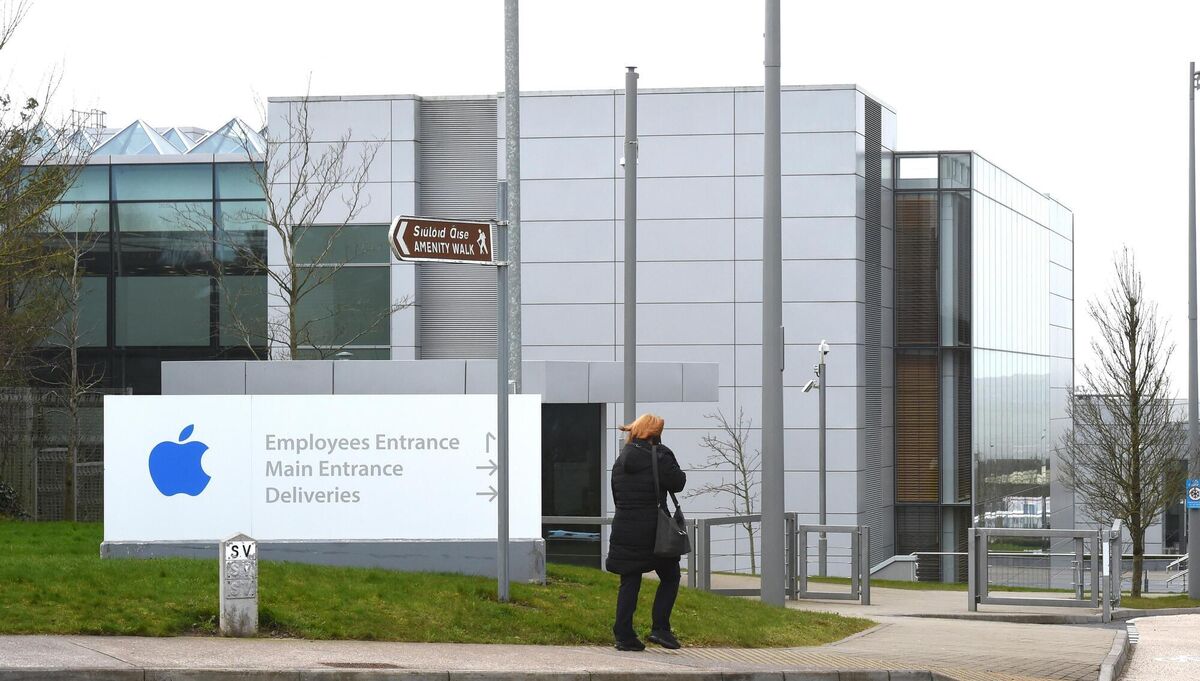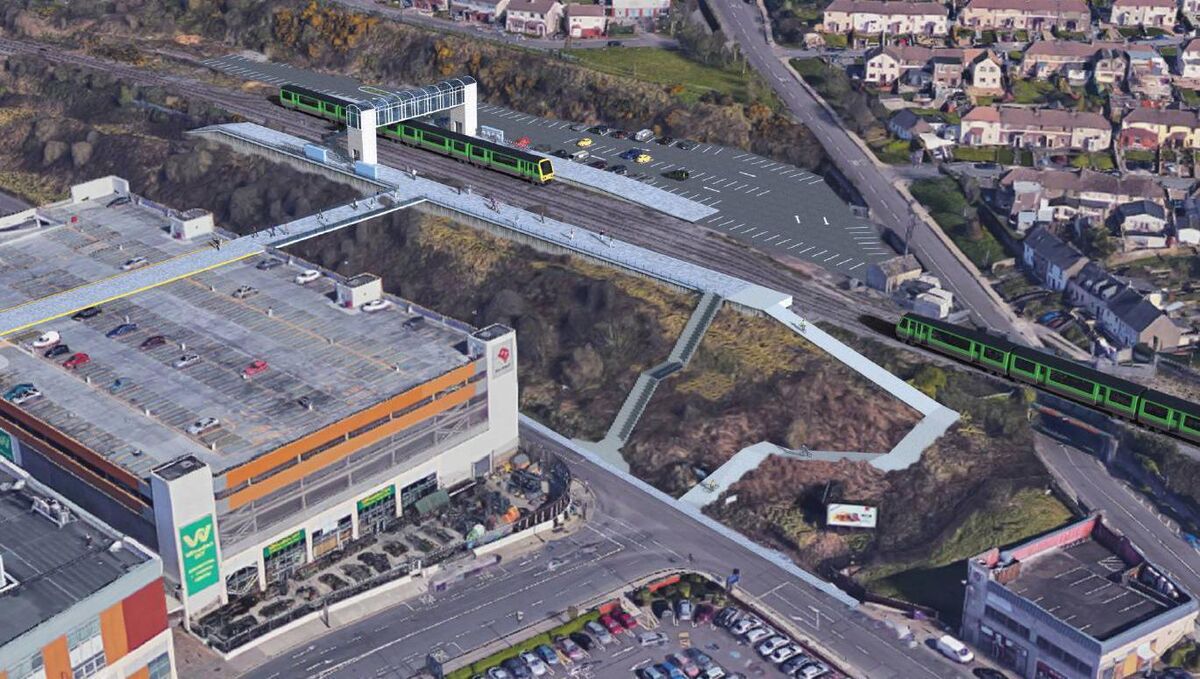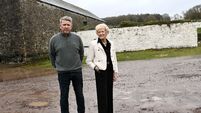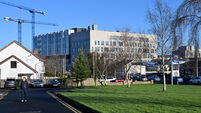Eoin English: Apple bites back over Cork's public transport shortcomings

Construction work at the Apple Computer campus in Hollyhill, Cork; completion of the so-called HH5 building, will boost employment on campus by over 1,000 when it opens later this year. File picture: Dan Linehan
Tech giant Apple arrived in Cork in 1980, setting up its fledgling Irish operation with a single manufacturing facility and 60 staff in what was then an unemployment blackspot.
Today, it is the city’s largest private employer, with a total staff headcount edging towards 5,350 and its sprawling Hollyhill campus, on a ridge overlooking the city, is a dominant feature on the landscape.
It reflects in many ways the company’s incredible trajectory of growth and expansion at Hollyhill over the last four and a half decades.
That growth and expansion has been facilitated by the state and by local government, which has included the relocation of residents of a Traveller halting site next door to a purpose-built housing scheme nearby, the construction of a new road around the campus, and the sale of two strategic landbanks to facilitate future expansion.
In return, the company has continued to expand and create thousands of new jobs.
But that phenomenal growth over the years has brought its own problems.
Apple has previously flagged with government its concerns about housing supply and the impact that has had on its staff.
It is now highlighting how delays with the delivery of planned public transport services, and of strategic road and active travel infrastructure, is affecting it.
Its latest expansion, the construction of the so-called HH5 building, will boost employment on campus by over 1,000 when it opens later this year.
Documents submitted as part of its planning application for 285 additional car park spaces lay bare the challenges faced by staff commuting to the hilltop site, especially given the lack of dedicated bus and bike infrastructure, and the unreliability of the existing bus service.
The documents also set out the massive efforts Apple has gone to to promote sustainable travel, including investing significantly in a major mobility management plan, and in the construction of a mobility hub.
But despite all of its efforts, it says there is a limit to what it can achieve and says the lack of appropriate transport infrastructure which BusConnects and the proposed Cork Northern Distributor Multi Mode Route will deliver presents a barrier to further improvements in the modal spilt — how staff travel to its site — in the short term.
“Until these barriers are overcome the applicants require a parking provision to serve the HH5 building which is in accordance with the revised parking standards in the Cork City Development Plan,” it says.
Apple has more than 2,500 car parking spaces on its site but heavily promotes sustainable transport options.
It operates its own shuttle bus service on three routes, from Ballincollig, Douglas, and the train station, carrying 500 employees a day on its busiest days.

It has developed a commute app for the service which also provides real time information on the public bus service.
It has an agreement with the Cork Connect bus service that enables Apple employee travel from the city to Hollyhill free of charge.
It has built ‘a commute hub’ on campus to encourage staff to use active travel modes or public transport, with secure covered parking for 170 regular bikes, 60 e-bikes, and 20 scooters.
The hub has real time information panels on bus timetables, it has showers, changing rooms, drying rooms, storage lockers, a bike repair and wash station and charging points for e-bikes and e-scooters.
It provides a free bike maintenance scheme, servicing about 80 bikes a month and its entrance foyer provides shelter for people waiting for a bus or taxi.
The campus has about 150 to 180 active car-poolers with a dedicated internal communication channel called Slack to connect employees travelling on the same routes at the same times.
There are 186 electric vehicle charging ports on the campus, with Apple investing significantly in a dedicated power substation to support the infrastructure, which has capacity for expansion.
The company has also developed a dedicated app that allows employees track vehicle charging progress, with a waitlist function built in that enables employees to reserve a space for electric vehicle charging during busy times.
Despite all of this, it says it needs the additional parking.
It argues that a variation to maximum parking standards in the 2022-2028 city development plan, and which was introduced in 2023 to reflect delays in delivery of BusConnects infrastructure and new services, it should be permitted to build one car parking space per 50sq m of development in this part of the city.
“Whilst 144 spaces are currently under construction as part of the ACCE Hollyhill 5 planning approval process, the applicant now intends to apply for the shortfall of 285 spaces that are within the updated maximum car parking standards through this planning submission,” one document says.
“The additional spaces are requested to provide short-medium term resilience and mitigate anticipated delays to the planned public transport and road network improvements ahead of the opening of the Hollyhill 5 building in mid-2025.
“In the longer term, there may be scope to repurpose these spaces to higher-value uses that support the expansion of the Apple campus — once the planned key upgrades to Cork’s transport network are delivered.”
It says while the original BusConnects timeline envisaged roll-out of infrastructure and services from 2024, that roll-out has been delayed to 2025 or 2026.
“The shuttle and existing public transport services will not address a shortfall in public transport connectivity for a sizeable number of employees that live outside of Cork City and suburban areas served by bus/shuttle that will need to be accommodated by the private car wither as drivers or passengers,” it says.
It points out that the Cork Metropolitan Area Transport Strategy (CMATS) proposed six park and ride facilities, including at Dunkettle and Blarney/Stoneview, connected by high-quality public transport services to key destinations.

“To date, none of these park and ride proposals have been delivered despite the establishment of a dedicated park and ride office in the NTA,” it says.
But it also says there is scope to gradually reduce car-parking availability at the Hollyhill campus over time after 2030, stressing that this potential future reduction relies on the delivery of public infrastructure including all the BusConnects Cork elements to ensure reliable bus journey times, a new train station at Blackpool/Kilbarry, with its associated interchange, the full implementation of the Cork Cycle Network alongside the NTA’s CycleConnects programme, a public e-bike system and other micromobility such as e-scooters, and more sustainable and affordable housing development in accessible areas.
A collection of the latest business articles and business analysis from Cork.















